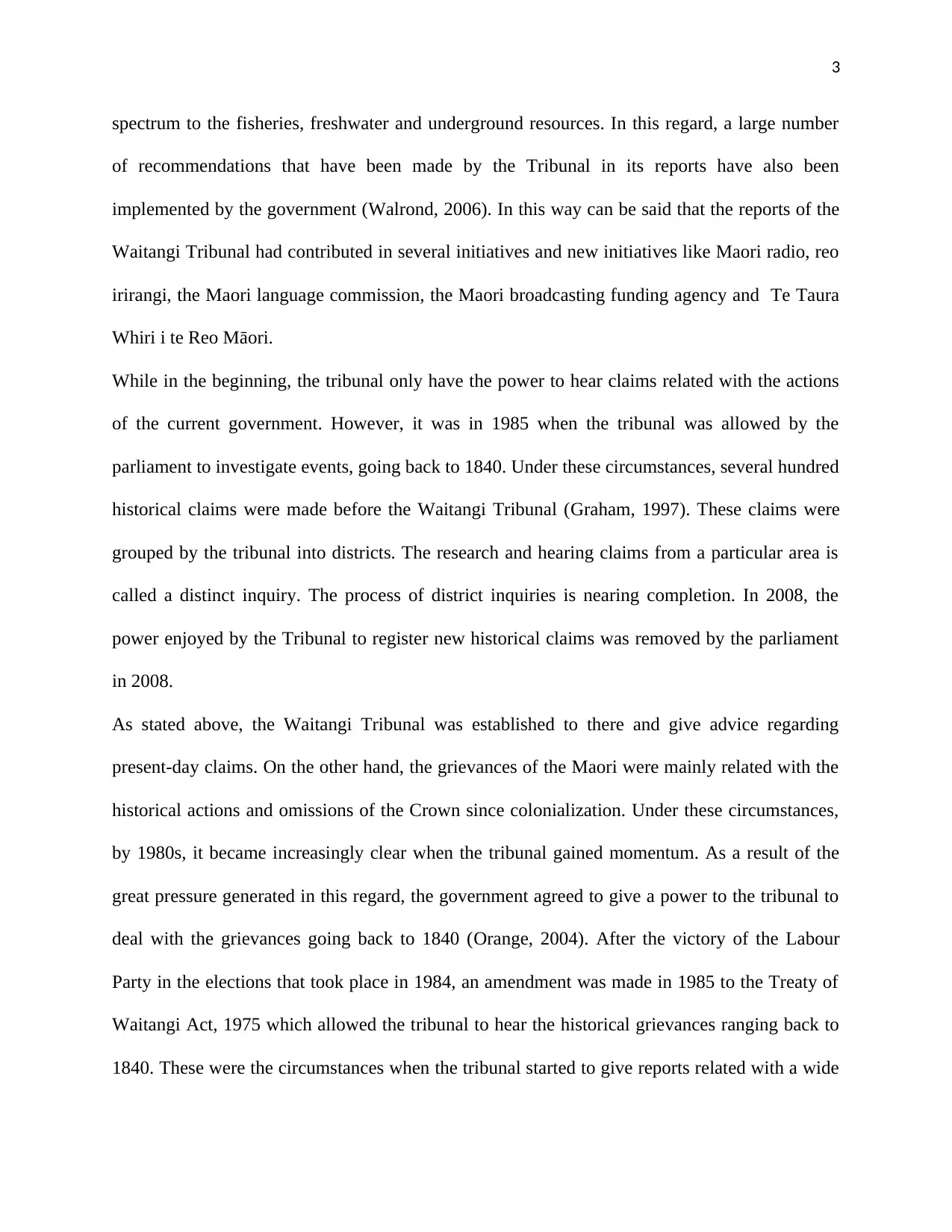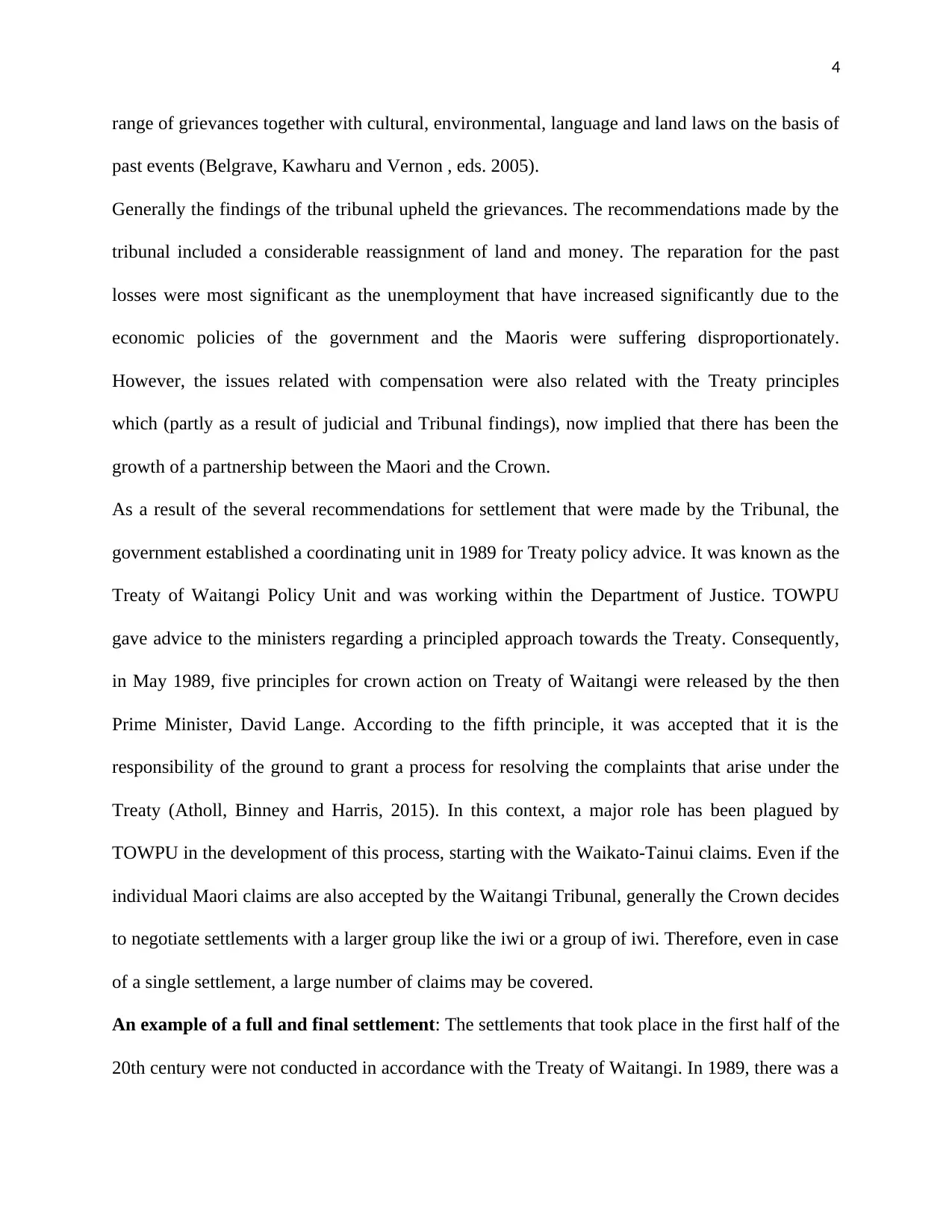Effectiveness of the Waitangi Tribunal in NZ: An Analysis
VerifiedAdded on 2020/03/23
|6
|1567
|202
Essay
AI Summary
This essay evaluates the effectiveness of the Waitangi Tribunal in addressing Maori grievances stemming from Crown breaches of the Treaty of Waitangi. It explores the tribunal's historical context, established by the Treaty of Waitangi Act 1975, and its evolution to address historical claims dating back to 1840. The paper details the tribunal's workings, including its investigations into various issues like land, fisheries, and cultural matters, and its role in recommending settlements and compensation. It highlights key settlements, such as the Waitomo Caves and Sealord fisheries agreements, demonstrating the tribunal's influence on land reassignment, financial reparations, and the establishment of Treaty principles in legislation. The essay examines the impact of the Waitangi Tribunal in revitalizing the Treaty of Waitangi, and its contribution to reconciliation between the Maori and the Crown, including the establishment of the Treaty of Waitangi Policy Unit.

1
Topic:
Student Name:
University:
Topic:
Student Name:
University:
Paraphrase This Document
Need a fresh take? Get an instant paraphrase of this document with our AI Paraphraser

2
Introduction: As a result of the establishment of Waitangi Tribunal, there has been the beginning
of several major changes in New Zealand regarding the relationships between Maori and Pakeha.
At the same time, the tribunal has also played an important role in revitalizing the Treaty of
Waitangi in order to deal with the grievances of the Maori regarding their land, fisheries and
several other issues. In the present paper, the effectiveness of the Waitangi Tribunal has been
evaluated in satisfying the grievances of the Maori that arise due to the breach by the Crown of
the provisions of the Treaty.
The history of the Waitangi Tribunal: The Waitangi Tribunal has been established by the
government under the Treaty of Waitangi Act, 1975. After the treaty was signed by the parties in
1840, there have been several complaints by the Maori that the terms of the Treaty have not been
properly fulfilled by the Crown. However, in most of the cases these petitions and protests went
unheard. It was even stated by a judge in 1877 that the treaty was in fact, a "legal nullity". It was
in 1970s when the protests of the Maori regarding the unresolved grievances related with the
Treaty started to rise and sometimes they took place beyond the law (Gardiner, 1996). In this
way, an attempt was made to provide a legal process, by setting up the Waitangi Tribunal,
through which the claims of the Maori related with the Treaty of Waitangi may be investigated.
At the same time, the inquiries made by the Waitangi Tribunal also help in resolving the Treaty
claims and also in the reconciliation of the issues that are outstanding between the Crown and the
Maori (Lean, 1999).
The workings of the Waitangi Tribunal: There are a number of significant issues regarding
which the Waitangi Tribunal has reported. These issues range from te reo Maori and the radio
Introduction: As a result of the establishment of Waitangi Tribunal, there has been the beginning
of several major changes in New Zealand regarding the relationships between Maori and Pakeha.
At the same time, the tribunal has also played an important role in revitalizing the Treaty of
Waitangi in order to deal with the grievances of the Maori regarding their land, fisheries and
several other issues. In the present paper, the effectiveness of the Waitangi Tribunal has been
evaluated in satisfying the grievances of the Maori that arise due to the breach by the Crown of
the provisions of the Treaty.
The history of the Waitangi Tribunal: The Waitangi Tribunal has been established by the
government under the Treaty of Waitangi Act, 1975. After the treaty was signed by the parties in
1840, there have been several complaints by the Maori that the terms of the Treaty have not been
properly fulfilled by the Crown. However, in most of the cases these petitions and protests went
unheard. It was even stated by a judge in 1877 that the treaty was in fact, a "legal nullity". It was
in 1970s when the protests of the Maori regarding the unresolved grievances related with the
Treaty started to rise and sometimes they took place beyond the law (Gardiner, 1996). In this
way, an attempt was made to provide a legal process, by setting up the Waitangi Tribunal,
through which the claims of the Maori related with the Treaty of Waitangi may be investigated.
At the same time, the inquiries made by the Waitangi Tribunal also help in resolving the Treaty
claims and also in the reconciliation of the issues that are outstanding between the Crown and the
Maori (Lean, 1999).
The workings of the Waitangi Tribunal: There are a number of significant issues regarding
which the Waitangi Tribunal has reported. These issues range from te reo Maori and the radio

3
spectrum to the fisheries, freshwater and underground resources. In this regard, a large number
of recommendations that have been made by the Tribunal in its reports have also been
implemented by the government (Walrond, 2006). In this way can be said that the reports of the
Waitangi Tribunal had contributed in several initiatives and new initiatives like Maori radio, reo
irirangi, the Maori language commission, the Maori broadcasting funding agency and Te Taura
Whiri i te Reo Māori.
While in the beginning, the tribunal only have the power to hear claims related with the actions
of the current government. However, it was in 1985 when the tribunal was allowed by the
parliament to investigate events, going back to 1840. Under these circumstances, several hundred
historical claims were made before the Waitangi Tribunal (Graham, 1997). These claims were
grouped by the tribunal into districts. The research and hearing claims from a particular area is
called a distinct inquiry. The process of district inquiries is nearing completion. In 2008, the
power enjoyed by the Tribunal to register new historical claims was removed by the parliament
in 2008.
As stated above, the Waitangi Tribunal was established to there and give advice regarding
present-day claims. On the other hand, the grievances of the Maori were mainly related with the
historical actions and omissions of the Crown since colonialization. Under these circumstances,
by 1980s, it became increasingly clear when the tribunal gained momentum. As a result of the
great pressure generated in this regard, the government agreed to give a power to the tribunal to
deal with the grievances going back to 1840 (Orange, 2004). After the victory of the Labour
Party in the elections that took place in 1984, an amendment was made in 1985 to the Treaty of
Waitangi Act, 1975 which allowed the tribunal to hear the historical grievances ranging back to
1840. These were the circumstances when the tribunal started to give reports related with a wide
spectrum to the fisheries, freshwater and underground resources. In this regard, a large number
of recommendations that have been made by the Tribunal in its reports have also been
implemented by the government (Walrond, 2006). In this way can be said that the reports of the
Waitangi Tribunal had contributed in several initiatives and new initiatives like Maori radio, reo
irirangi, the Maori language commission, the Maori broadcasting funding agency and Te Taura
Whiri i te Reo Māori.
While in the beginning, the tribunal only have the power to hear claims related with the actions
of the current government. However, it was in 1985 when the tribunal was allowed by the
parliament to investigate events, going back to 1840. Under these circumstances, several hundred
historical claims were made before the Waitangi Tribunal (Graham, 1997). These claims were
grouped by the tribunal into districts. The research and hearing claims from a particular area is
called a distinct inquiry. The process of district inquiries is nearing completion. In 2008, the
power enjoyed by the Tribunal to register new historical claims was removed by the parliament
in 2008.
As stated above, the Waitangi Tribunal was established to there and give advice regarding
present-day claims. On the other hand, the grievances of the Maori were mainly related with the
historical actions and omissions of the Crown since colonialization. Under these circumstances,
by 1980s, it became increasingly clear when the tribunal gained momentum. As a result of the
great pressure generated in this regard, the government agreed to give a power to the tribunal to
deal with the grievances going back to 1840 (Orange, 2004). After the victory of the Labour
Party in the elections that took place in 1984, an amendment was made in 1985 to the Treaty of
Waitangi Act, 1975 which allowed the tribunal to hear the historical grievances ranging back to
1840. These were the circumstances when the tribunal started to give reports related with a wide
⊘ This is a preview!⊘
Do you want full access?
Subscribe today to unlock all pages.

Trusted by 1+ million students worldwide

4
range of grievances together with cultural, environmental, language and land laws on the basis of
past events (Belgrave, Kawharu and Vernon , eds. 2005).
Generally the findings of the tribunal upheld the grievances. The recommendations made by the
tribunal included a considerable reassignment of land and money. The reparation for the past
losses were most significant as the unemployment that have increased significantly due to the
economic policies of the government and the Maoris were suffering disproportionately.
However, the issues related with compensation were also related with the Treaty principles
which (partly as a result of judicial and Tribunal findings), now implied that there has been the
growth of a partnership between the Maori and the Crown.
As a result of the several recommendations for settlement that were made by the Tribunal, the
government established a coordinating unit in 1989 for Treaty policy advice. It was known as the
Treaty of Waitangi Policy Unit and was working within the Department of Justice. TOWPU
gave advice to the ministers regarding a principled approach towards the Treaty. Consequently,
in May 1989, five principles for crown action on Treaty of Waitangi were released by the then
Prime Minister, David Lange. According to the fifth principle, it was accepted that it is the
responsibility of the ground to grant a process for resolving the complaints that arise under the
Treaty (Atholl, Binney and Harris, 2015). In this context, a major role has been plagued by
TOWPU in the development of this process, starting with the Waikato-Tainui claims. Even if the
individual Maori claims are also accepted by the Waitangi Tribunal, generally the Crown decides
to negotiate settlements with a larger group like the iwi or a group of iwi. Therefore, even in case
of a single settlement, a large number of claims may be covered.
An example of a full and final settlement: The settlements that took place in the first half of the
20th century were not conducted in accordance with the Treaty of Waitangi. In 1989, there was a
range of grievances together with cultural, environmental, language and land laws on the basis of
past events (Belgrave, Kawharu and Vernon , eds. 2005).
Generally the findings of the tribunal upheld the grievances. The recommendations made by the
tribunal included a considerable reassignment of land and money. The reparation for the past
losses were most significant as the unemployment that have increased significantly due to the
economic policies of the government and the Maoris were suffering disproportionately.
However, the issues related with compensation were also related with the Treaty principles
which (partly as a result of judicial and Tribunal findings), now implied that there has been the
growth of a partnership between the Maori and the Crown.
As a result of the several recommendations for settlement that were made by the Tribunal, the
government established a coordinating unit in 1989 for Treaty policy advice. It was known as the
Treaty of Waitangi Policy Unit and was working within the Department of Justice. TOWPU
gave advice to the ministers regarding a principled approach towards the Treaty. Consequently,
in May 1989, five principles for crown action on Treaty of Waitangi were released by the then
Prime Minister, David Lange. According to the fifth principle, it was accepted that it is the
responsibility of the ground to grant a process for resolving the complaints that arise under the
Treaty (Atholl, Binney and Harris, 2015). In this context, a major role has been plagued by
TOWPU in the development of this process, starting with the Waikato-Tainui claims. Even if the
individual Maori claims are also accepted by the Waitangi Tribunal, generally the Crown decides
to negotiate settlements with a larger group like the iwi or a group of iwi. Therefore, even in case
of a single settlement, a large number of claims may be covered.
An example of a full and final settlement: The settlements that took place in the first half of the
20th century were not conducted in accordance with the Treaty of Waitangi. In 1989, there was a
Paraphrase This Document
Need a fresh take? Get an instant paraphrase of this document with our AI Paraphraser

5
mediated negotiation related with a land-based claim in accordance with the Treaty of Waitangi.
The land at Waitomo Caves , which was a major tourist attraction, had been transferred to the
two hapu, whose territory was included in these caves. As a result, the tourism management and
other connected processes had to be shared with the Department of conservation and the license
fees for guiding and souvenir sales had to be divided between the Maori owners and the Crown.
$1 million loan was given by the Crown to the Maori owners as an advance.
The significance of the inclusion of Treaty principles in a piece of legislation: Many more
Treaty claims were settled in the following four years. The 'Sealord' settlement was a major one,
which was a follow-up on interim pan-tribal fisheries settlement in 1989. The government had
also bargained full and final settlement of all the Maori claims related with commercial fishing in
1992 under the Treaty (Bargh, 2007). It was the first one which covered all the tribes. They were
assisted by the government to purchase 50% of the Sealord Fisheries Company, given 20%
shares of the new quota of fish and also a fisheries commission for the purpose of distributing the
assets. The settlement was worth nearly $170 million in total and it also gave traditional food
gathering rights.
mediated negotiation related with a land-based claim in accordance with the Treaty of Waitangi.
The land at Waitomo Caves , which was a major tourist attraction, had been transferred to the
two hapu, whose territory was included in these caves. As a result, the tourism management and
other connected processes had to be shared with the Department of conservation and the license
fees for guiding and souvenir sales had to be divided between the Maori owners and the Crown.
$1 million loan was given by the Crown to the Maori owners as an advance.
The significance of the inclusion of Treaty principles in a piece of legislation: Many more
Treaty claims were settled in the following four years. The 'Sealord' settlement was a major one,
which was a follow-up on interim pan-tribal fisheries settlement in 1989. The government had
also bargained full and final settlement of all the Maori claims related with commercial fishing in
1992 under the Treaty (Bargh, 2007). It was the first one which covered all the tribes. They were
assisted by the government to purchase 50% of the Sealord Fisheries Company, given 20%
shares of the new quota of fish and also a fisheries commission for the purpose of distributing the
assets. The settlement was worth nearly $170 million in total and it also gave traditional food
gathering rights.

6
References
Atholl, A., Binney, J., Harris. A., (2015) Tangata Whenua, Wellington: Bridget Williams Books,
2015.
Bargh, M. (2007) "Maori Development and Neoliberalism." in M. Bargh (ed.), Resistance: An
Indigenous Response to Neoliberalism, Wellington: Huia
Belgrave, M. Kawharu M and Vernon D W., eds. (2005) Waitangi Revisited: Perspectives on the
Treaty of Waitangi. Melbourne: Oxford University Press
Gardiner, W. (1996) Return to Sender; what really happened at the fiscal envelope hui.
Auckland: Reed.
Graham, D. (1997). Trick or Treaty? Wellington: Institute for Governance and Policy Studies at
Victoria University of Wellington
Lean, M. (1999). "Getting the Government to Say Sorry". For a Change. Initiatives of Change.
Archived from the original on 28 February 2014. Retrieved 15 August 2006
Orange, C. (2004) An Illustrated History of the Treaty of Waitangi. Wellington: Bridget
Williams Books.
Walrond, C. (2006). "Fishing Industry" Te Ara: The Encyclopedia of New Zealand. Retrieved 15
August 2006
References
Atholl, A., Binney, J., Harris. A., (2015) Tangata Whenua, Wellington: Bridget Williams Books,
2015.
Bargh, M. (2007) "Maori Development and Neoliberalism." in M. Bargh (ed.), Resistance: An
Indigenous Response to Neoliberalism, Wellington: Huia
Belgrave, M. Kawharu M and Vernon D W., eds. (2005) Waitangi Revisited: Perspectives on the
Treaty of Waitangi. Melbourne: Oxford University Press
Gardiner, W. (1996) Return to Sender; what really happened at the fiscal envelope hui.
Auckland: Reed.
Graham, D. (1997). Trick or Treaty? Wellington: Institute for Governance and Policy Studies at
Victoria University of Wellington
Lean, M. (1999). "Getting the Government to Say Sorry". For a Change. Initiatives of Change.
Archived from the original on 28 February 2014. Retrieved 15 August 2006
Orange, C. (2004) An Illustrated History of the Treaty of Waitangi. Wellington: Bridget
Williams Books.
Walrond, C. (2006). "Fishing Industry" Te Ara: The Encyclopedia of New Zealand. Retrieved 15
August 2006
⊘ This is a preview!⊘
Do you want full access?
Subscribe today to unlock all pages.

Trusted by 1+ million students worldwide
1 out of 6
Your All-in-One AI-Powered Toolkit for Academic Success.
+13062052269
info@desklib.com
Available 24*7 on WhatsApp / Email
![[object Object]](/_next/static/media/star-bottom.7253800d.svg)
Unlock your academic potential
Copyright © 2020–2025 A2Z Services. All Rights Reserved. Developed and managed by ZUCOL.

